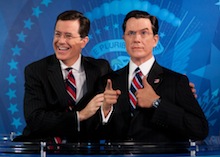CBS’s decision to replace David Letterman with Stephen Colbert has local TV managers wondering how the change will affect late-night news ratings.

- Graeme Newell-Researcher, speaker with 602 Communications
Marketing researcher Graeme Newell of 602 Communications explained how what follows a newscast can affect the newscast itself.
“There is an in-flow and an out-flow that happens with television,” he said. Even though we can effortlessly skip from channel to channel with the push of a remote button, viewers still tend to keep watching a channel until they are prompted to change, but it takes prompting.
“I will give you the example of early-morning news,” Newell said. “When the ‘Today Show’ was huge, NBC local stations would see a monster final quarter hour in their local morning newscasts as people turned on their TVs to catch the ‘Today Show’ that was coming on next.”
The same effect holds from prime-time viewing into late local news. What is less clear, however, is how much “out-flow” effect there in late-night viewing when the competition is not so much another station but sleep.

- Tom Griesdorn-Former local TV general manager
Longtime local television general manager Tom Griesdorn (who is a guest faculty teacher in our Poynter Producer Project seminar) told me that “there’s always a little backwash effect from local to network.” But Griesdorn, who worked as a GM for 30 years, said the more significant byproduct of a successful late-comedy show is that people who are watching late local news might not turn it off midway through the broadcast. They might stick around.
Local news often suffers from a drop-off in the second quarter hour because the content that lives there, including weather forecasts, are not as valuable as they once were since weather information is available anywhere, anytime. And local sports suffers from the same challenges.
Griesdorn says local stations don’t make much money from shows that air after the late news because networks generally consume the first half hour of the late show with national advertising. Plus, networks may ask or even pressure local stations to limit the amount of commercials they place between late local news and the late-night program to give viewers less of a chance to leave between shows. Some stations place 90 seconds or more of high-value ads in that space.
“Local newscasts should be thoughtful about how they close their late show,” Newell said. “We have trained viewers to go away. How many times do you hear the anchor say ‘goodnight’ when they should say ‘stay tuned?'”
Oddly, Griesdorn said, a successful late-show can also affect early morning viewing. “It is still true that if you watch a channel at night, you are still very likely to turn the same channel on first thing in the morning.” Have we become that lazy that we can’t be bothered turning the channel the next day? “We are human,” Griesdorn said. “We have habits.”






